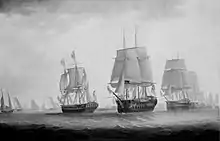HMS Southampton (1757)
HMS Southampton was the name ship of the 32-gun Southampton-class fifth-rate frigates of the Royal Navy. She was launched in 1757 and served for more than half a century until wrecked in 1812.

_RMG_B6883_(cropped).jpg.webp) HMS Southampton | |
| History | |
|---|---|
| Name: | HMS Southampton |
| Ordered: | 12 March 1756 |
| Builder: | Robert Inwood, Rotherhithe |
| Laid down: | April 1756 |
| Launched: | 5 May 1757 |
| Completed: | 19 June 1757 at Deptford Dockyard |
| Commissioned: | April 1757 |
| Fate: | Wrecked in the Bahamas, 27 November 1812 |
| General characteristics | |
| Class and type: | Southampton-class fifth-rate frigate |
| Tons burthen: | 671 64⁄94 bm |
| Length: |
|
| Beam: | 35 ft 0 in (10.67 m) |
| Depth of hold: | 12 ft 1 in (3.68 m) |
| Sail plan: | Full-rigged ship |
| Complement: | 210 officers and men |
| Armament: | |
In 1772, Southampton – at the time commanded by the capable John MacBride, destined for a distinguished naval career – was sent to Elsinore, Denmark, to take on board and convey to exile in Germany the British Princess Caroline Matilda, George III's sister, who had been deposed from her position as Queen of Denmark due to her affair with the social reformer Johan Struensee.[1]
On 3 August 1780, Southampton captured the French privateer lugger Comte de Maurepas, of 12 guns and 80 men, under the command of Joseph Le Cluck. She had on board Mr. Andrew Stuart, Surgeon's Mate of HMS Speedwell, "as a ransomer."[2] She had suffered shot holes between wind and water and sank shortly thereafter. Southampton shared the head money award with Buffalo, Thetis, and Alarm.[3]
Southampton took part in the Action of 9 August 1780, when a convoy she was escorting fell prey to a Franco-Spanish squadron. 55 merchantmen were captured, but she managed to escape.[4]
On 10 June 1796, Southampton captured the French corvette Utile at Hyères Roads, by boarding. Utile was armed with twenty-four 6-pounder guns and was under the protection of a battery. She had a crew of 136 men under the command of Citizen François Veza. The French put up a resistance during which they suffered eight killed, including Veza, and 17 wounded; Southampton had one man killed.[5] The Royal Navy took her into service as HMS Utile. Gorgon, Courageux, and the hired armed cutter Fox were in company at the time,[6] and with the British fleet outside Toulon. They shared with Southampton in the proceeds of the capture, as did Barfleur, Bombay Castle, Egmont, and St George.[7]
Lloyd's List reported that she and the sloop-of-war HMS Brazen had run aground and lost their masts on the coast of Mississippi during a great hurricane on 19 and 20 August 1812, but that the crews were saved.[8] Both vessels were refloated, repaired, and returned to service.
On 22 November, Southampton, under the command of Captain James Lucas Yeo, captured the American brig USS Vixen. Vixen was armed with twelve 18-pounder carronades and two 9-pounder bow chasers, and had a crew of 130 men under the command of Captain George Reed. She had been out five weeks but had not captured anything.[9]
Fate
A strong westerly current wrecked Southampton and Vixen on an uncharted submerged reef off Conception Island[10] in the Crooked Island Passage of the Bahamas on 27 November. No lives were lost.[11]
_RMG_J0560.png.webp)
Footnotes
Notes
Citations
- The relevant chapter of Norah Lofts' "The Lost Queen", a biography of Caroline Matilda, takes place on board the Southampton and is told from the point of view of the ship's Captain, John MacBride.
- Gentleman's magazine (1780), p. 391.
- "No. 12325". The London Gazette. 24 August 1782. p. 1.
- Lacour-Gayet (1905), p. 318.
- "No. 13912". The London Gazette. 16 July 1796. p. 681.
- "No. 15557". The London Gazette. 8 February 1803. p. 165.
- "No. 14073". The London Gazette. 12 December 1797. p. 1195.
- Lloyd's List, – accessed 18 December 2013.
- "No. 16701". The London Gazette. 9 February 1813. p. 277.
- Haken, Lippold; Vixen Crew Member (2004) [1813]. "Underwater Pictures and Narrative of the Capture of the United States' Brig Vixen by one of the Vixen's Crew" (PDF). Retrieved 14 December 2013.
- Gossett (1986), pp. 86–87.
References
- Demerliac, Alain (1996) La Marine De Louis XVI: Nomenclature Des Navires Français De 1774 À 1792. (Nice: Éditions OMEGA). ISBN 2-906381-23-3
- Gardiner, Robert (1992) The First Frigates. (London: Conway Maritime Press). ISBN 0-85177-601-9.
- Gossett, William Patrick (1986) The lost ships of the Royal Navy, 1793–1900. (London: Mansell). ISBN 0-7201-1816-6
- Hepper, David J. (1994). British Warship Losses in the Age of Sail, 1650–1859. Rotherfield: Jean Boudriot. ISBN 0-948864-30-3.
- Lacour-Gayet, Georges (1905). La marine militaire de la France sous le règne de Louis XVI. Paris: Honoré Champion. OCLC 763372623.
- Lyon, David (1993) The Sailing Navy List. (London: Conway Maritime Press). ISBN 0-85177-617-5.
- Winfield, Rif (2007) British Warships in the Age of Sail, 1714 to 1792. (London: Seaforth Publishing). ISBN 978-1-84415-700-6.
External links
 Media related to HMS Southampton (ship, 1757) at Wikimedia Commons
Media related to HMS Southampton (ship, 1757) at Wikimedia Commons